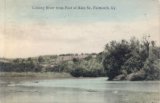
 |
 |
| Bird's eye View of Falmouth from Reservoir Hill |
Bird's Eye View of Falmouth, 1928 |
 |
 |
 |
| S. Licking Just Above the RR Bridge, c. 1905 |
The Narrows of the Licking, Falmouth |
Licking River from the Foot of Main Street, Falmouth |
| This 1964 flood scene is more impressive
once you understand that the dog is standing on top
of a flooded car. (Those two black marks are just crop marks from a newspaper editor back in '64.) The Gulf Station was at the corner of Dickerson lane and US 27 |
![]()
New York Clipper, October 15, 1881
 |
 |
 |
 |
 |
 |
| Shelby & Park Streets | ||
| These six views are all from the 1964 Falmouth flood from a Facebook post by Steve Blades, of photos taken by George Parsons |
||
| Falmouth in the 1948 flood. '48 was the 8th worst flood in recorded history in Cincinnati, but relatively little is written about it- most folks in the area had seen the huge '37 flood, and besides, had just won a world war. The 8th worst flood ever was nothing. The 4th worst flood ever? 1945. Flood level history is here. |
![]()
 |
 |
| Main Licking, Looking East | Bird's Eye View of Falmouth |

Cincinnati Commercial Tribune, February 3, 1849
South Licking Valley
 |
 |
 |
 |
Licking River Scenes
![]()
 |
| An anonymous author wrote a navigation guide to the Licking in 1818. We've transcribed it for you. |
| The Falmouth Outlook reported heavy rains the week of January 15, 1937, but two weeks later, the 37 flood had hit with its total force. The Outlook's extensive coverage from January 29 is here, and a recap from February 5 is here. | |
| Falmouth petitioned to make the Licking navigable in 1899. The government declined it. Details and maps are here. | T. M. Barton's book of poetry, Lyrics of the Licking, from 1865, can be read on this site. |
| Bob Ranking writes in 1954 about where to fish in the South Licking. | Here's the story of how they're going to dam up the Licking at Falmouth in 1925. |
| Kenneth T. Marquette's account of the 1964 Falmouth flood is here. (pdf) | “The Steamer John Morgan made an effort to reach Falmouth last week, but was prevented from so doing
by a smash-up near Catawba.” From the Covington Journal, April 20, 1872 |
| “On last Thursday, a party of ladies and gentlemen gathered at the river, their object being to hunt pearls. The came out early and brought well filled baskets, of course. We all did ample justice to the good things spread before us. After dinner the evening was most enjoyably spent in the pearl business. Some of those engaged were so lucky as to find some very nice specimens.” from the Falmouth Outlook, September 11, 1908. | “(Special to the Ticket) Falmouth, Jan. 16., -The river is higher now than since the year 1854, and rising at the rate of 13 inches per hour. It is moving up in the town rapidly. The Main street bridge has been swept away. The negro portion of this place is entirely flooded. great many negroes were taken from the tops of their shanties this morning in boats.” Covington's The Ticket, January 17, 1877 (“Always Independent, Seldom Indifferent”) |
| “Cincinnati, Ohio, Aug. 1. The Times-Star special reports very heavy rains last night in Kentucky. Both branches of Licking river at Falmouth are higher than ever known and rising three feet and four inches. Great damage to crops and bridges is apprehended.”Los Angeles Herald, Volume XVII, Number 138, 2 August 1882 | |
| “Licking Rivers. At Falmouth, on the latter river, the distilleries, saw mills and other manufactories were submerged and suffered much loss. The river was full of the contents of fields and granaries. Many bridges on the turnpikes throughout the country were carried away. At Butler, Ky., the Licking was within a few inches of the highest mark known, which occurred in 1854.” Los Angeles Herald, February 5, 1887 | |
Congress gave approval for a dam on the Licking in 1936.
The Corps of engineers give more detail here.
Note it's it the extreme southeast corner of Pendleton County, above Falmouth.
![]()
| Remember when the Licking River flowed north to Hamilton, Ohio, and the Kentucky River turned northeast at Carrollton and headed for Cincinnati? No? That’s because you were born after the last glacier left the area. Read all about it, here. |
![]()





